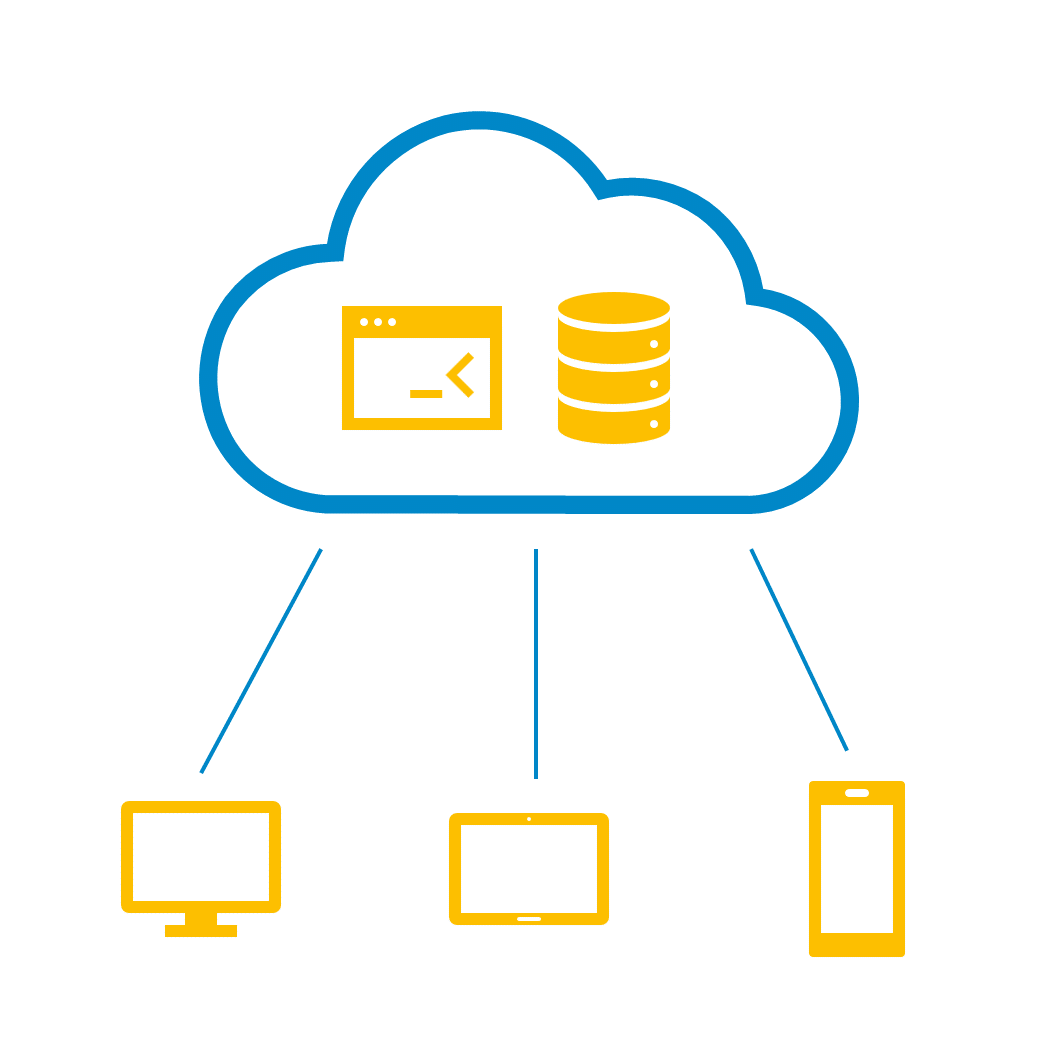Software-as-a-Service
What is SaaS?
Software-as-a-Service (SaaS) refers to a model where software is hosted and delivered in the cloud. As opposed to the classic license model, users no longer have to install the software themselves. Instead, subscriptions and access via web browser are common. In this article, you will learn everything you need to know about the advantages and use cases of the SaaS model.
Definition
How does Software-as-a-Service (SaaS) work?
Software-as-a-Service (short: SaaS) is a cloud-based model for the licensing and delivery of software applications.
When a software is offered as SaaS, a customer can access and use it via the Internet without having to install the software themselves. Hosting, maintenance and updates are commonly handled by the SaaS provider.
For the users of such SaaS applications, the model offers some core advantages: Companies are able to save costs on servers, staff and IT service providers while at the same time reducing the complexity of their own IT infrastructure. Furthermore, many SaaS applications offer additional benefits when it comes to usability, security and scalability.
Due to these reasons, more and more companies are adopting the use of SaaS for all sorts of core tasks and business functions. Today, a wide variety of applications are available as Software-as-a-Service, including Customer Relationship Management (CRM) and Enterprise Resource Planning (ERP) systems such as Salesforce and SAP, text and image editing software like Microsoft Word and Adobe Photoshop or messaging platforms such as Slack.

Advantages
What are the advantages of Software-as-a-Service?
For users of SaaS applications, the most important advantages include the following:
- Lower costs for IT infrastructure and personnel
- Quick adoption
- Improved access options
- Performance optimization
- Scalability and flexibility
- Low investment risk
- Improved collaboration
Lower costs for IT infrastructure and personnel:
When using SaaS software, companies save costs for hardware, databases, security systems and similar expenses existing in a classic on-premises model. Furthermore, IT services such as maintenance, backups and updates can be shifted to the SaaS provider, reducing costs for external IT service providers and allowing the IT department to focus on different projects. Last but not least, costs for SaaS subscriptions tend to be a lot more transparent.
Quick adoption:
Since SaaS applications do not require a separate installation, companies can often get started with using software right after a completing a subscription.
Improved access options:
The SaaS model offers worldwide access to software via web browser, requiring only a stable internet connection. Unlike many traditional installations, access is not restricted to a company network and there is no need to configure firewalls or VPN solutions.
Performance optimization:
Using load balancing and resource scaling technologies, SaaS providers can ensure that their services remain fully available and perform at a high level even in the event of increased usage.
Scalability and flexibility:
Especially with larger SaaS providers, companies often have the option to flexibly expand or reduce their usage of software. This allows companies to immediately react and adapt to structural changes or similar developments.
Low investment risk:
SaaS software does not require complex installation and set-up processes, which significantly reduces the cost of an initial investment. Additionally, larger providers almost always offer free trials for their software.
Improved collaboration:
Larger SaaS offerings commonly include functions that span multiple departments and allow for easy data access between employees.
For many companies, Software-as-a-Service offers provide the opportunity for a greater focus on their core business. Thanks to SaaS applications, even smaller companies with limited resources are able to benefit from a wide range of software functions and high security standards without having to make their own infrastructure investments and accept the corresponding risks.
Examples
Industrial examples for Software-as-a-Service
Both private users and companies of all sizes can benefit from SaaS applications when compared to self-installed software.
In the following use cases, we focus on examples from the industrial sector where SaaS applications are used across departments and for a wide variety of tasks:
Customer Relationship Management:
Using CRM systems, companies can manage and document customer communications while automating core sales processes. The advantage of location-independent access to cloud-based applications is particularly relevant in this area, as sales employees are working from all around the world.
Enterprise Resource Planning:
ERP systems offered as Software-as-a-Service allow for a centralized management of personnel, customer orders and resources such as materials, documents, licenses or finances on a single cloud-based platform.
Supply Chain Management:
Cloud-based SCM systems allow companies to manage deliveries, inventories and logistics data in one central location.
IT Service Management:
ITSM applications enable centralized management of a company’s IT infrastructure in the cloud, offer documentation options and support specialists in dealing with incidents, requests and other tasks.
Software-as-a-Service for industrial production
Industrial manufacturers also benefit from cloud software that is available anywhere & anytime and enables an intelligent management and monitoring of production processes.
An example for SaaS in this area is manubes, our cloud platform for digital production management. With manubes, you are not only able to collect, store and visualize production data but also automate central production processes using the manubes workflow builder.
manubes offers all the core advantages of the Software-as-a-Service and Platform-as-a-Service models:
- Access to manubes can be set up within minutes.
- The platform offers worldwide access on a wide range of end devices.
- Modern cloud technology ensures a high level of security and performance.
- manubes allows you to create specialized applications for visualization, management and automation of production processes.

Optimize your production with manubes
manubes offers a central platform for production data management, data visualization and workflow-based process automation.
Manufacturers gain access to a variety of innovative tools in order to quickly develop their own applications – tailored to their requirements.
Models
Related models – PaaS, IaaS and more
Alongside Software-as-a-Service, there are other related „as-a-Service“ models that are based on cloud computing.
Platform-as-a-Service (PaaS)
In the PaaS model, the provider offers access to an environment (platform) for the development, operation and management of software applications.
Infrastructure-as-a-Service (IaaS)
In an IaaS model, the provider makes (virtual) computer infrastructure available in the cloud on which an end user can install and operate their own software.
Everything-as-a-Service
Everything-as-a-Service is simply the approach of making a wide variety of things („everything“) available in the cloud. This includes the aforementioned „as-a-Service“ models, but also numerous other services and new technologies such as databases, games, messaging and artificial intelligence.
Trends & Future Outlook
Current trends in SaaS
The market for Software-as-a-Service has been characterized by strong growth for years. statista forecasted a SaaS market size of 232 billion U.S. dollars for 2024.
A report by Gartner also predicts strong growth in cloud-based service offerings. According to the market research company, up to 70% of companies could be using industrial cloud platforms by 2027 (compared to 15% in 2023).
Many companies are recognizing the advantages of the SaaS model and software providers have been moving away from traditional licensing models for some time now.
Furthermore, a trend towards an ever greater range of functions can be observed in SaaS offerings from larger providers. Increasingly, platforms are being made available that connect a wide variety of business areas (logistics, production, administration, marketing, IT) and combine central company functions in one single interface.
Try manubes for free
Test the different manubes features in your personal cloud environment.
